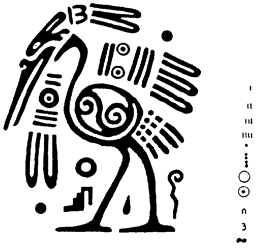 |
Science Frontiers ONLINE No. 76: Jul-Aug 1991 |
|
|
The mexican sellos: possible evidence for early european contacts
 Mexican sello with stylized heron incorporating Libyan characters, such as those listed at the right. |
Since many of the Mexican sellos date back to 1200 BC, the implication is that Old World-New World contacts occurred long before the Christian era.
But, asks G.F. Carter in his long article on the sellos, if the ancient peoples of Mexico and Central America did absorb Old World symbols, "Why was the alphabet not developed instead of the clumsy hieroglyphics?"
(Carter, George F.; "Mexican Sellos: Writing in America, or the Growth of an Idea?" Epigraphic Society, Occasional Papers, 19:159, 1990.)
Comment. Hieroglyphics do appear clumsy to us, but perhaps it is because we do not fully appreciate them. There may be nuances of shape and rendition that convey more than the bare translation of the glyph, just as a sonnet is more than the sum of its words.